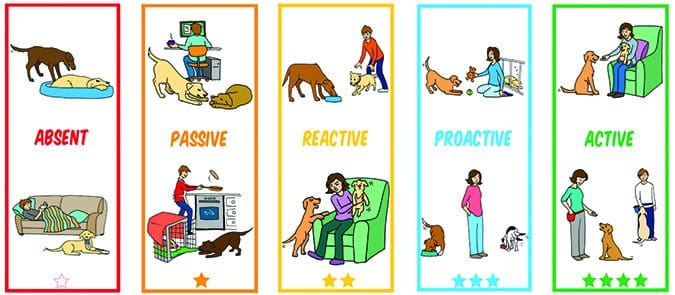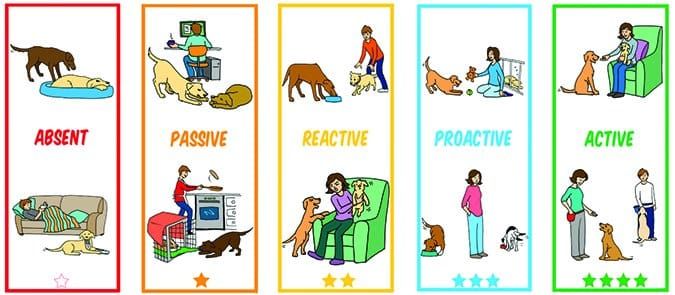I’ve always been neurotic about the safety of living beings in my care – more so since I became a mother of two at a young age. This only increased when I became a professional trainer. I consider the care and safety of our children and animals to be of utmost importance – and good supervision is at the crux of this, especially in our fast-paced world, where we are all distracted by technology and are fantastic multi-taskers.
I believe that supervision is never more important than when observing our dogs in social settings, whether it is introducing new dogs, exercising our dogs at a dog park, bringing our dogs with us in the public domain, or just living in multi-dog households. When I say “supervision,” I am talking about adult management by someone who is knowledgeable about dog body language.
I would venture to say that many people think they are great at overseeing their dogs, but in reality, they don’t really have a firm grasp of what ideal supervision means. Further, many people lack information about their dogs’ body language – so, even if they are actually actively watching their dogs, if they can’t recognize their dogs’ stress signals, they won’t be able to help the dogs.
Some time ago, I saw a graphic about various levels or types of supervision, created by Family Paws Parent Education – a wonderful organization dedicated to educating the public about child and dog safety. With their permission, I revised their graphic to the one below, to reflect proper supervision for the safety of dogs in the presence of other dogs.
Let’s explore the difference between supervision that keeps all the members of a household safe and the kind that either does nothing or actually makes things less safe.
Absent supervision.
It’s absolutely fine to leave multiple dogs together, unsupervised, when they are familiar with each other and have a (properly managed) history of peaceful interactions. But if you bring a new dog or puppy into the family, have a friend’s dog over for a play-date, or a family member stops by with their dog, leaving the dogs unsupervised can lead to one or both of them getting injured physically or emotionally traumatized.
In the absent-supervision scenario, a child might be distracted with an electronic device, while the family dog is happily chewing on a shoe – or perhaps there is no one around at all to notice that the sleeping dog is being bothered by the other dog.
Things can happen in an instant and in the end, it’s the dog who will suffer, by either being punished (or even just shunned) for chewing on something or for pestering the other dog into an altercation.

Mighty Dog Graphics
Passive supervision.
This is when we are in the room but not really paying attention or supervising at all. We are distracted with other things, and won’t necessarily notice right away that one dog is not happy with the interaction and showing signs of stress. Even if we are savvy about canine body language, if we aren’t even paying attention, we will miss the signs that an intervention is needed to help one (or both!) of the dogs stay safe.
If one dog wants to rest while the other is instigating play, even in a friendly way, the situation can go awry in minutes. Now imagine that the dog who is resting in the crate is also a little muscle-sore from a long play session that morning, or is an older dog with everyday pain from arthritis, and the younger dog keeps invading his resting space. Without supervision, the senior dog is left to his own devices to protect his space. This is a set-up for failure and an unecessary risk.
Reactive supervision.
We are all guilty of this at one time or another. We are present, we are watching, but we haven’t proactively managed the situation and something has happened. In this situation, we react out of fear.
Be aware that when we are reactive, we create a negative association for our dogs. Our stress makes our dogs stressed – and everyone’s behavior deteriorates under stress.
Say your dog is eating and your new puppy runs up to the dog happily; the pup is not yet aware that this could turn south in a second. Your son or daughter, who knows your older dog doesn’t like to be bothered when eating, sees what is about to happen and yells and runs to grab the puppy before he gets any closer.
Dogs often react to our reactions. When we get upset about something, it triggers our dogs to be on the alert that something is not right and they better be on the alert, too.
The adult dog may or may not have had a problem with the oncoming puppy; left to his own devices, he may have been about to display some great non-violent communication that would help teach the puppy some boundaries. But since we have reacted negatively to the puppy running up to him, the dog may well be sparked into perceiving that the puppy rushing him is a bad thing; given the reaction of the small human, he may feel he has to respond in a dramatic way, too.
Or say you are holding a smaller dog (or a cat, or baby) on your lap when your big dog comes rushing in to greet you enthusiastically. If you are surprised and not thinking ahead, but simply reacting, you may yell at the oncoming dog while whisking the smaller dog (or cat or baby) out of reach. Again, this sends a negative tone to the oncoming dog, who may, in turn, develop negative associations to the little one.
Proactive supervision.
This is getting close to the best type of supervision. We realize that in order to keep everyone in a household safe, we need to manage the environment and calmly head off potential problems well before unsafe interactions happen. This is crucial to the process of having dogs get along safely, while maintaining a positive association with us and each other.
While the adult is playing with or training one dog, the other dog – perhaps a less-experienced youngster, one with poorer impulse control, or a dog who is new to the household – is laying safely on the other side of a puppy gate. Taking turns playing and training dogs while you are still in the process of learning about the dogs is key to future safe interactions. Teaching each dog to be patient – making sure they each get a turn at individualized, reinforcing attention – will go a long way toward building a true bond with and between your dogs.
In the next image, an adult stands between the dogs while they are eating. This is an alert, proactive way to manage the situation that can be created if one dog finishes first and begins casting about for more food. With the adult watching over them and physically creating a barrier between them, both dogs feel more secure.
This level of supervision is really good – but don’t stop here! There’s an even higher level that will provide even greater rewards for all the members of your household.
Active supervision.
Active supervision is the best and highest level of management. These adults understand dog behavior and body language and are fully present and actively teaching and interacting with the dogs.
In the scenario discussed earlier – with the adult with a smaller dog in her lap – she hears or sees the excited dog rushing into the house. She is prepared with high-value rewards and ready to calmly and clearly ask the oncoming dog for a sit, then reward him with a treat or toy and warm praise when he does the requested behavior. Her body language and voice are calm and deliberate, showing no signs of reactivity or fear when the dog approaches.
Setting boundaries through teaching builds the dogs’ trust in the adult and helps foster calm and pleasant interactions between the dogs. Boundaries help dogs feel safe.
In the active supervision image, you see two adults teaching each dog to sit. The adults are enthusiastic and engaged, and this in turn helps the dogs to engage with them, building the dogs’ trust that the humans have created a safe environment for everyone.
Good Supervision Prevents Life or Death Situations
In case any of this seems over-the-top, you should be aware that the most common reason that dogs are relinquished to shelters is due to behavioral issues. It just makes sense to learn as much as you can about canine body language (especially stress signals) and proactive management of your dogs, and to practice calm, reward-based training on a daily basis. These things will reduce our dogs’ stress, increase their sense of security, and, critically, prevent tragic behavioral outcomes.





